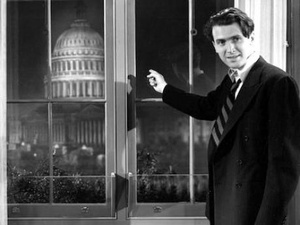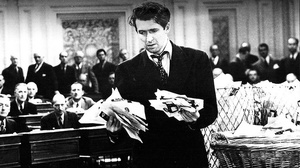Snap Shot U.S.: It takes a scandal

Film, Mr. Smith Goes to Washington, Image Credit: Flickr Creative Commons
The history of political finance transparency in the U.S. is one of fits and starts, marked by improvements that grow out of reaction to a corruption scandal, followed by declines that are often the result of efforts to ignore or undo laws already in place. In the U.S., the pattern began in the late 1800s, when Congress responded to a government corruption scandal with the Pendleton Act of 1883. The legislation was an effort to ensure that government jobs were awarded on the basis of merit, not on patronage. The Pendleton Act also prohibited soliciting campaign donations on Federal government property.
But, because the Pendleton Act meant parties and candidates could no longer promise good jobs in exchange for campaign cash, they began to rely on corporations and businesses for their funding. That, in turn, led to allegations of outsized corporate influence on President Theodore Roosevelt. To counter those claims, Roosevelt led the fight for the Tillman Act of 1907, which made it illegal for banks or corporations to make campaign contributions. (In 1947, a ban on labor contributions was added to the corporate contribution ban.)
Bans are not particularly effective without disclosure, and in 1910, the Federal Corrupt Practices Act built upon the Tillman act, requiring political parties (but not candidates) to disclose their spending in post-election reports.
Soon after, news of the Teapot Dome scandal rocked Washington. In that case, the Secretary of the Interior granted oil-drilling rights in exchange for cash and gifts that would be valued at more than $4 million dollars today. The resulting amendments to the FCPA in 1925 included a requirement that contributions over $100 be disclosed.
The FCPA was ineffective and largely ignored for nearly 50 years, when Congress replaced it with the Federal Election Campaign Act of 1971. Among other things, FECA required full reporting of campaign contributions and expenditures. After the Watergate scandal brought to light major campaign finance abuses, the law was amended to establish the Federal Election Commission, an independent agency that is supposed to monitor and enforce the campaign finance laws and disclose campaign finance information. It also provided for public funding of presidential elections and imposed strict limits on both contributions and expenditures by candidates and parties. The Supreme Court in Buckley v. Valeo struck down the spending limits, but upheld FECA’s disclosure provisions.
The decades after FECA followed a predictable trajectory in the scandal-reform cycle; a congratulatory pat on the back for a job well done, some period of success, and, eventually, a return to business as usual. Ultimately, an arms race for so-called “soft money” in the 1990s led to the Bipartisan Campaign Reform Act of 2002. The FEC—the agency supposedly meant to enforce campaign finance laws—actually triggered the scandal by claiming that money that was not used for election activities couldn’t be regulated. This opened the door for the parties to raise unlimited funds from corporations, labor unions and wealthy individuals for “party building activities.” On the one hand, party building activities could be seen as paying the rent and keeping the lights on at party headquarters, but before long, so-called party building meant the parties paid for television ads that were indistinguishable from election ads except that they said, “Call Congressman Smith and tell him to stop being soft on criminals” instead of “Vote against Congressman Smith.”
Selling access to the candidates—even overnight stays in the Lincoln bedroom at the White House—became a favorite tool as both parties attempted to amass huge amounts of soft money. The soft money scandal resulted in more than 60 subpoenas to Democratic operatives and forced the Democrats, with a little help from Republican Senator John McCain, who had been rocked by his own corruption scandal, to act in order to save face.
The resulting Bipartisan Campaign Reform Act banned soft money. Corporations and unions were prohibited from contributing any money for any purpose to national political parties or federal candidates. The law also prohibited corporations and unions from paying for “sham issue ads”–the “call Senator Jones and tell her to raise the minimum wage” ads that don’t specifically say vote for or vote against Senator Jones—if they occurred in the middle of the election. The Supreme Court upheld all of these provisions by a vote of 5-4 in a 2003 challenge to the bill
And while it wasn’t perfect—money has a way of seeping in through the cracks in any system—massive access and influence buying contributions were mostly kept at bay until the Supreme Court decided Citizens United in 2010. In that case, the court decided that unlimited contributions from corporations and wealthy individuals would not have a corrupting influence on the U.S. political system as long as they were independent from the candidates’ campaigns, opening the door to over a billion dollars of unlimited, often secret money in the 2012 elections.
But Citizens United also upheld the importance of disclosure, stating, “With the advent of the Internet, prompt disclosure of expenditures can provide shareholders and citizens with the information needed to hold corporations and elected officials accountable for their positions and supporters.” The Court went on to say that disclaimer and disclosure requirements “impose no ceiling on campaign-related activities” and that “transparency enables the electorate to make informed decisions and give proper weight to different speakers and messages.” Unfortunately, there is no transparency regime in the U.S. that will shine a light on corporate or union funding of the activities of outside groups. Efforts to create a disclosure regime up to the task of making these outside expenditures transparent have failed in Congress.

Film, Mr. Smith Goes to Washington, Image Credit: Flickr Creative Commons
And then it got worse. In McCutcheon v. FEC, decided in early 2014, the Supreme Court lifted the caps on what a donor is able to give to all candidates, committees and parties combined, opening the door for a single donor to contribute more than $3.5 million to a party’s candidates and committees. In addition, the McCutcheon court dangerously narrowed the definition of corruption. Buying access to a candidate or elected official is not, in the court’s view, corruption. Instead, the only corrupting influence money can have is if it is given directly in exchange for a vote or government action.
The more-money-equals-more-speech crowd is claiming that lifting the contribution limits is good for transparency. After all, contributions to candidates, parties and PACs are already disclosed so allowing more money to flow through these channels means there will be more disclosure.
But there are at least two problems with that argument. First, undisclosed dark money will remain. Donors who want their massive contributions to the political process to remain secret can continue to launder dark money through nonprofits. Second, the disclosures that currently apply to parties and candidates only make information public on a monthly or quarterly basis, too long to wait to find out who is behind a massive check to a party or candidate.
It is probably safe to say US citizens have more disclosure about the workings of our government than we did during the Gilded Age or the Cold War, and US laws provide better access to political finance information than many others across the globe. Nevertheless, the United States is far from the model of open government that it should be or that some people claim it is. The U.S. is at a something of a crossroads right now, where the fight is not one of giving citizens more access to information, but to ensure we hold on to the transparency measures reformers have worked so hard over the history of this country to achieve. It may be the height of cynicism, but it seems that the U.S. is on the verge of another scandal rocking the foundations of accountable government. Those who are fighting against corruption must be prepared with strong, new ways to promote government transparency.

